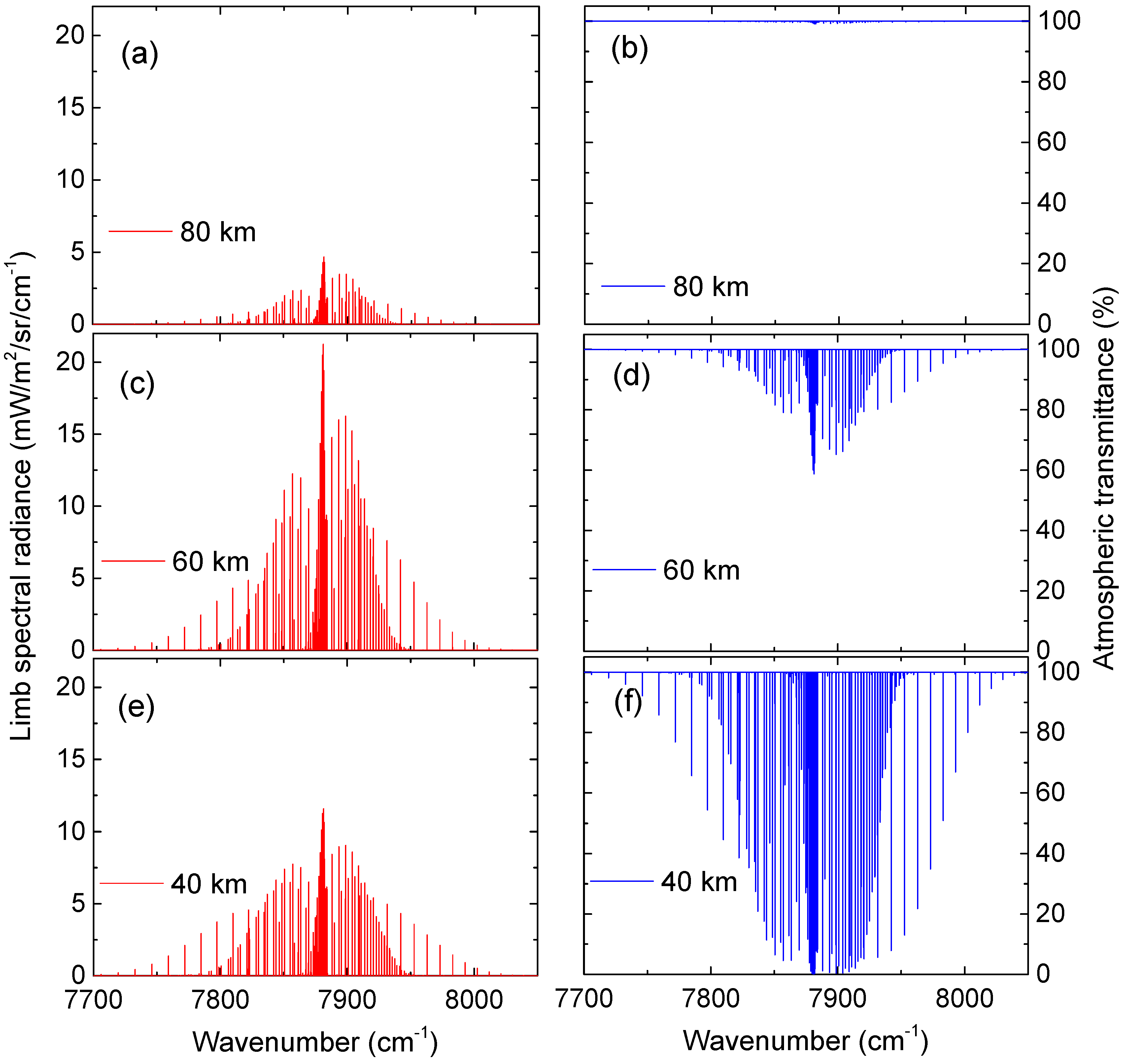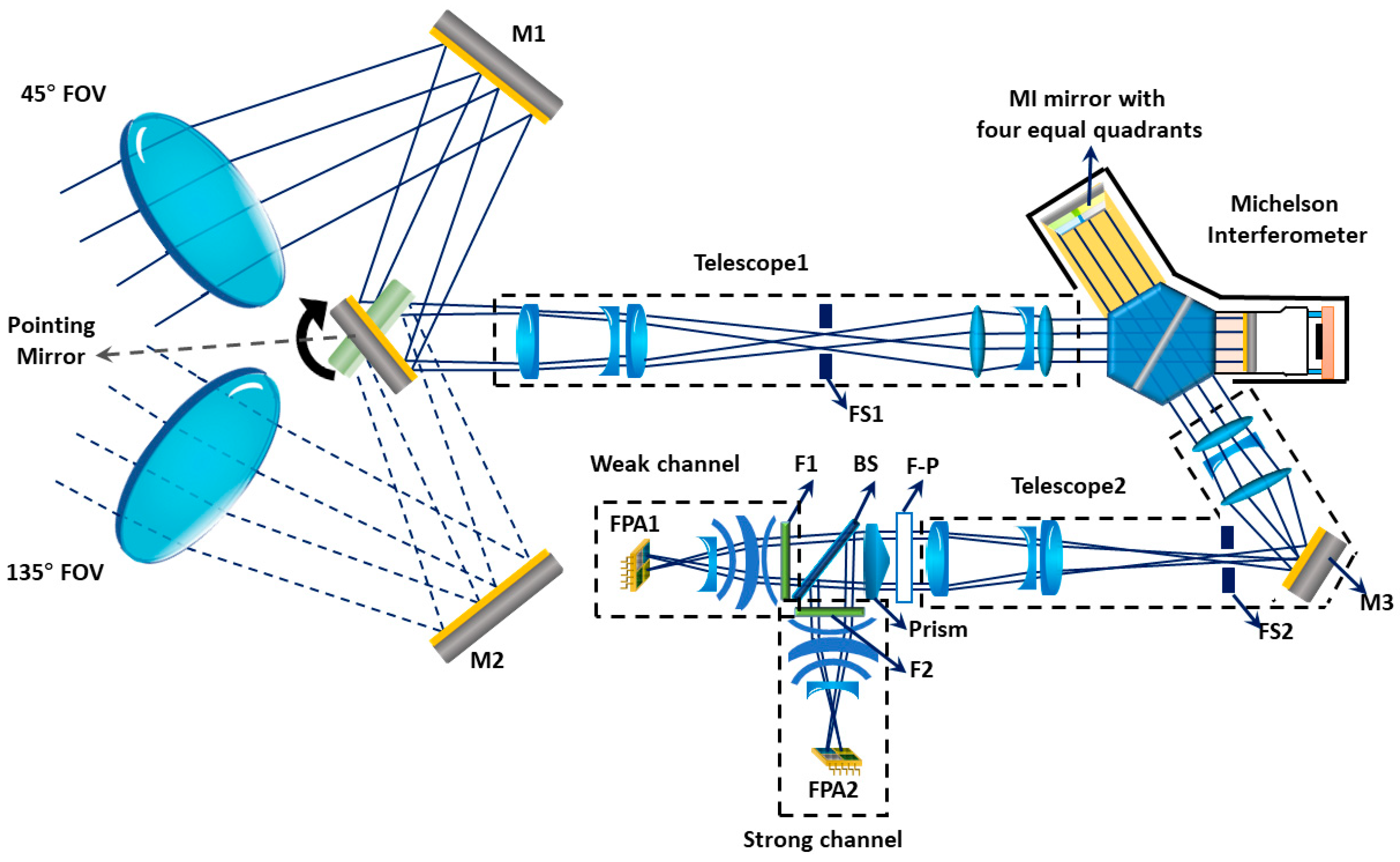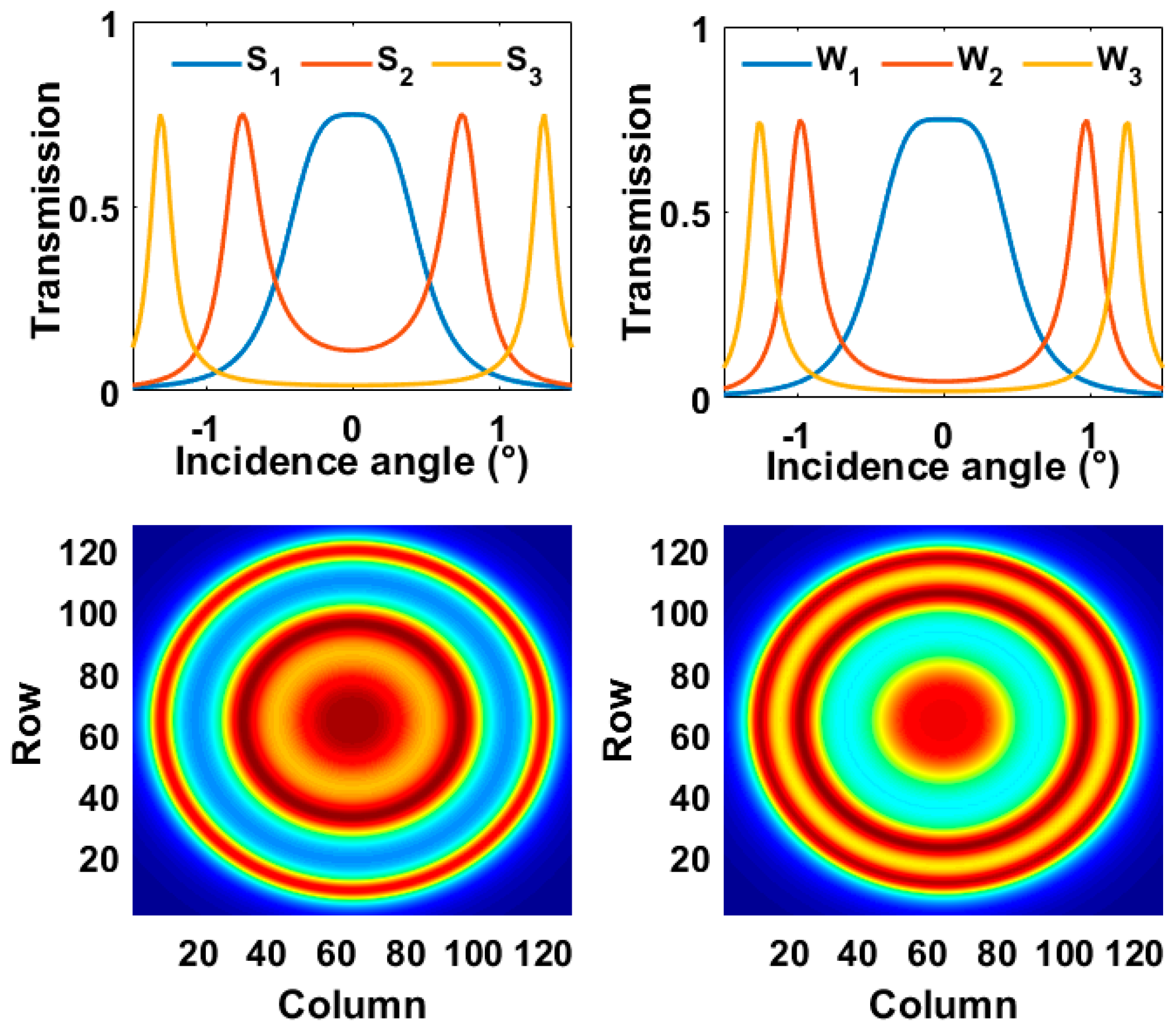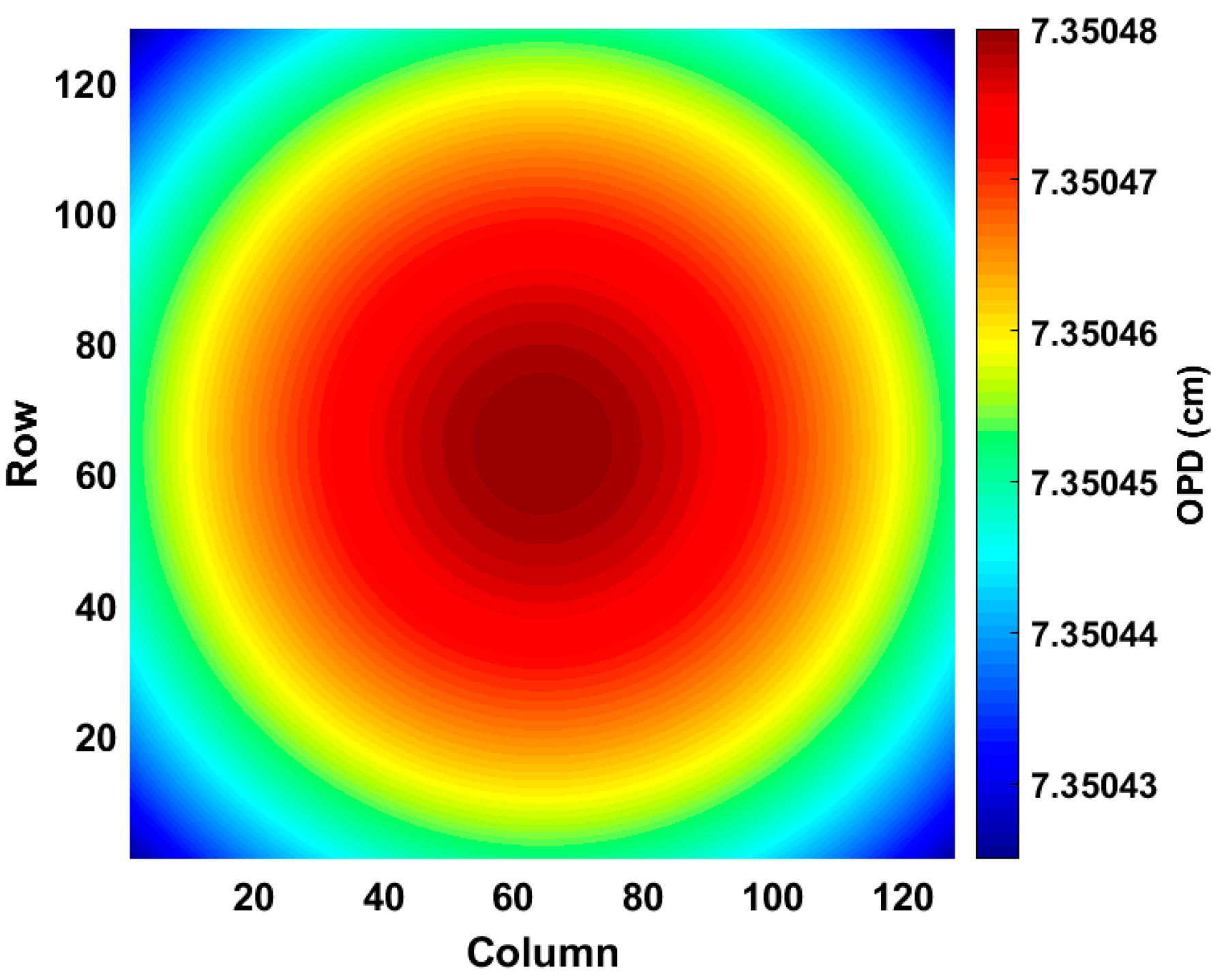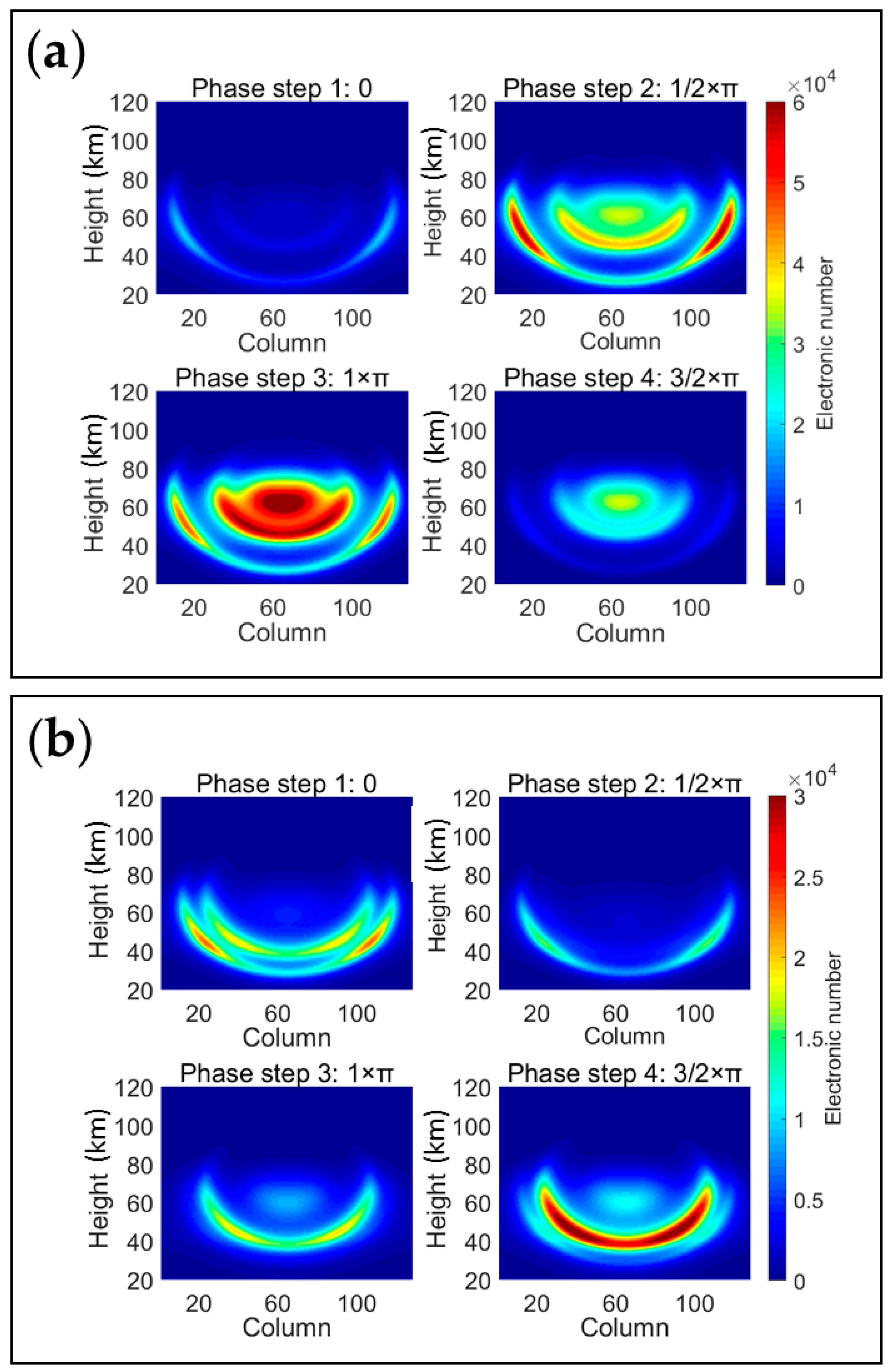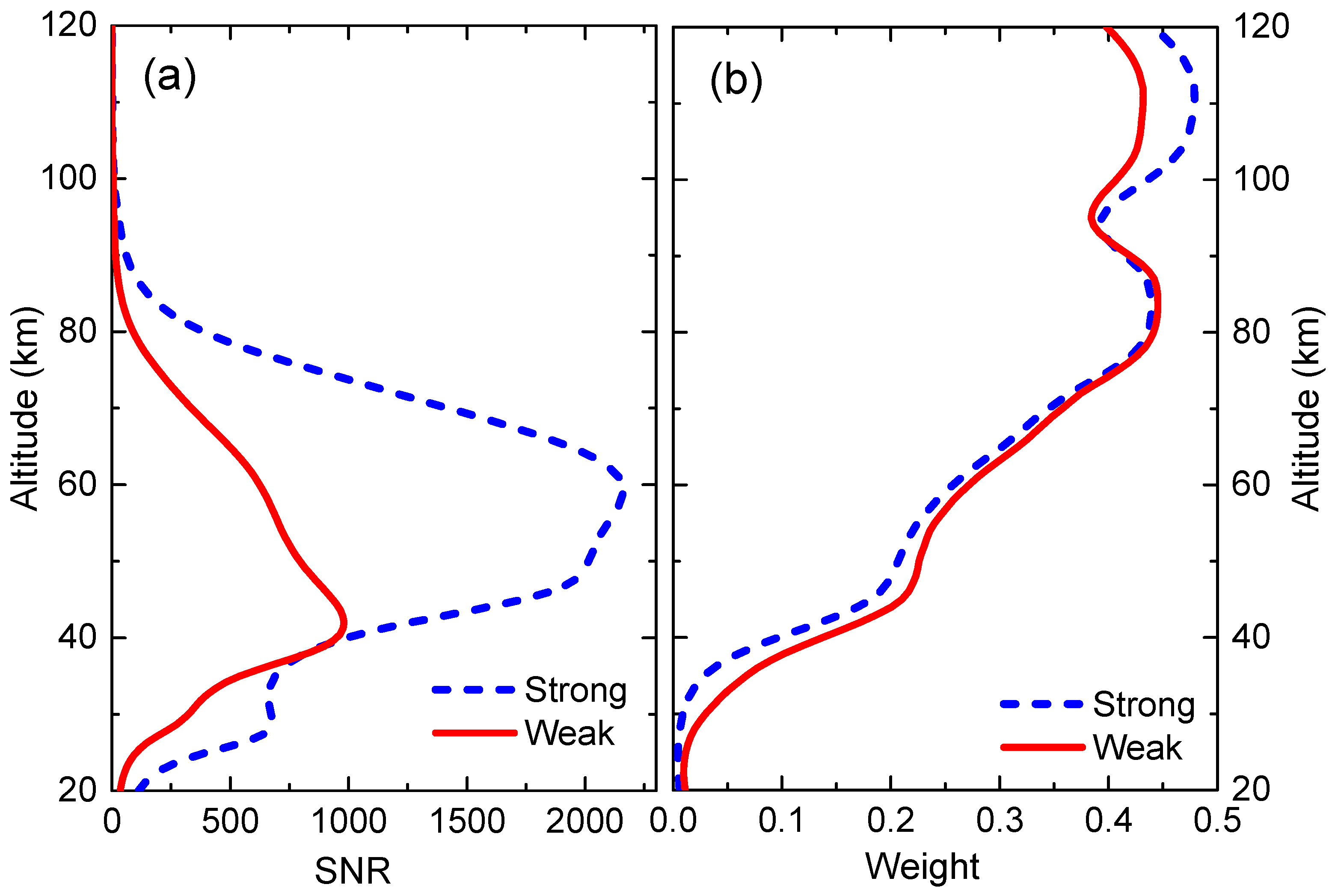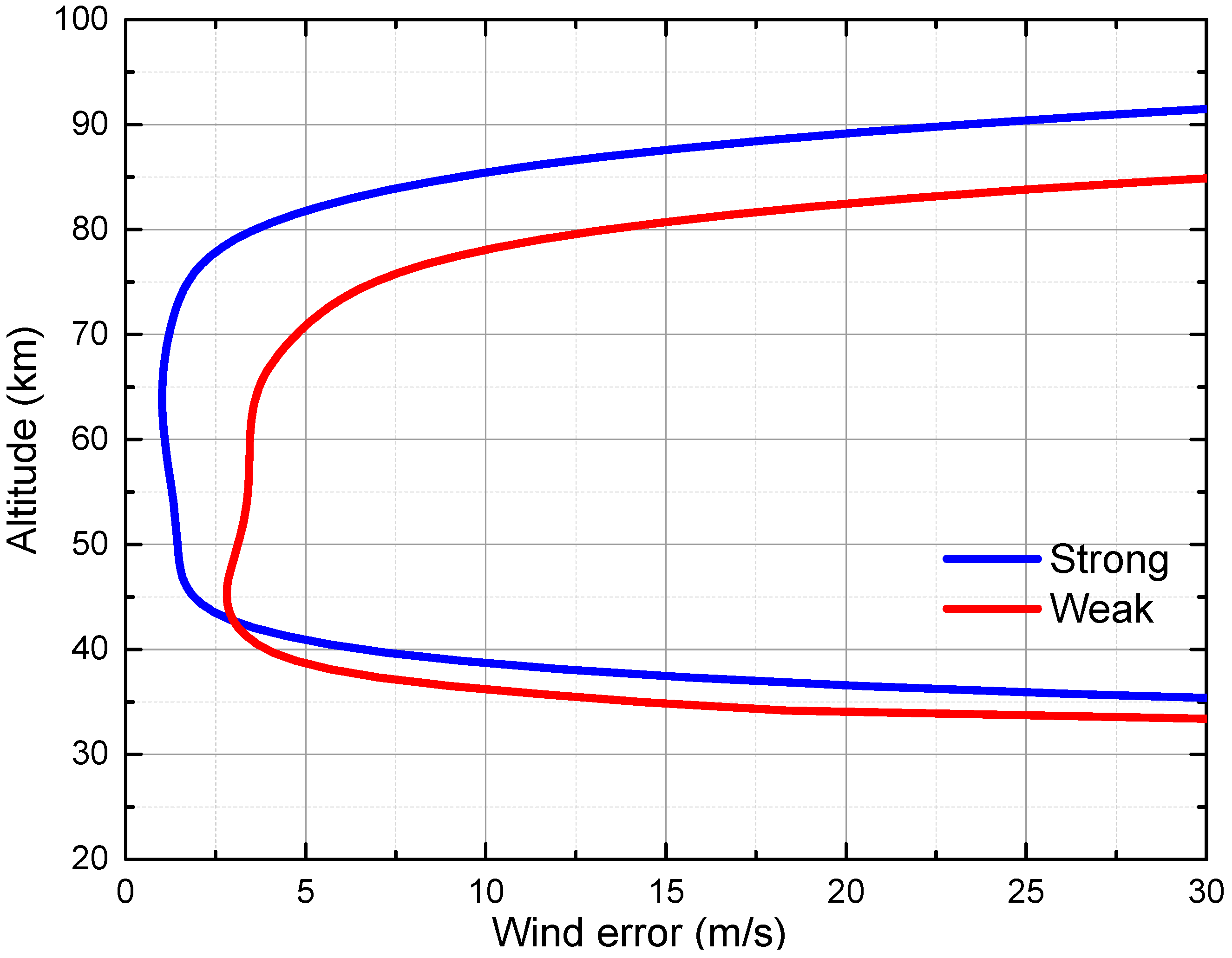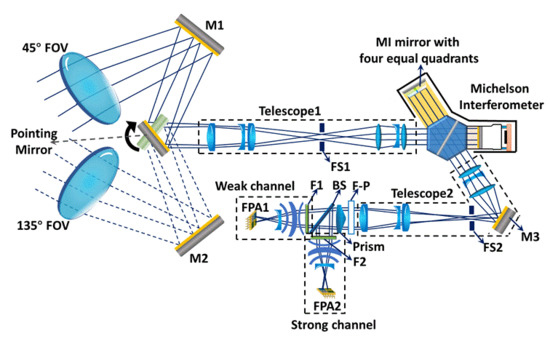1. Introduction
Near space is generally defined as an altitude range from 20 km to the “edge of space”—the Kármán line—at 100 km, and has started to play an increasingly important role in atmospheric physics and space science [
1]. Wind and temperature are two extremely important physical quantities to characterize the atmosphere parameters of the near space. Both wind and temperature measurements are of great scientific significance for studying the semiannual oscillation of the middle atmosphere [
2], global structure, and seasonal variability of the migrating diurnal tide [
3], the momentum and energy fluxes of monochromatic gravity waves [
4], and the planetary waves excited by wind interaction with topography [
5]. In addition, sensitive observations of atmospheric wind and temperature have great practical value for improving the accuracy of environmental prediction, ensuring aerospace safety, and achieving a higher satellite launch success rate.
For a long time, the detection of atmospheric wind and temperature has been largely restricted to ground-based remote sensing technologies, such as Doppler wind light detection and ranging (LIDAR) [
6], Raman temperature LIDAR [
7], meteor radar [
8], and airglow imaging interferometer [
9]. The continuous development of space technology creates favorable conditions for observing wind and temperature from satellites. The spaceborne airglow imaging interferometer measures the atmospheric wind and temperature globally by detecting the broadening, frequency shift, and intensity change of the airglow spectrum from limb-viewing satellites, and therefore provides greatly enhanced vertical spatial resolution. Due to traction needs, spaceborne wind and temperature interferometry is becoming the frontier topic of the satellite remote sensing field [
10].
Wind calculation is obtained from the Doppler frequency shift of the airglow by measuring the phase change of the interferogram, and the temperature is usually calculated from the Doppler broadening by analyzing the interferogram contrast change. The phase change of the interferogram is more sensitive than the contrast change, leading to a higher accuracy for wind inversion (about 5 to 8 m/s) than for temperature measurement (about 20 to 75 K). For airglow emissions from diatomic or polyatomic molecules, the atmospheric temperature can also be determined from the relative intensities of two isolated emission lines if the emission is in the thermodynamic equilibrium with the ambient atmosphere. The two-line ratio method has been proven to yield greater accuracy for temperature measurements (about 1 to 3 K). The Wind Imaging Interferometer (WINDII) [
11] on the Upper Atmosphere Research Satellite (UARS) measured wind and temperature in the altitude range from 75 to 320 km using the red line (630.0 nm) and green line (557.7 nm) of the O atom and rotational lines in the atmospheric A band (762 nm) of the O
2 molecule. On the same satellite, the High-Resolution Doppler Imager (HRDI) is loaded to detect the atmospheric wind and temperature from the stratosphere (10 to 40 km) to the mesosphere and lower thermosphere (50 to 120 km) with the absorption and emission characteristics of three vibrational bands, (0,0), (1,0), and (2,0) in the
transition of the O
2 molecule, achieving a wind measurement accuracy of about 5 m/s [
12] and a temperature accuracy of about 7 K [
13].
The remarkable success of WINDII and HRDI stimulates interest in taking atmospheric wind and temperature at lower altitudes to yield more altitude coverage. A concept for an instrument called the Stratospheric Wind Interferometer for Transport studies (SWIFT) was developed by employing the Doppler Asymmetric Spatial Heterodyne (DASH) approach and using the vibration–rotation ozone line at 1133.4335 cm
-1 as the Doppler target for the stratospheric wind measurement. [
14,
15]. The Doppler Wind and Temperature Sounder (DWTS) instrument employs gas filter correlation radiometry technology, and was initiated to simultaneously measure the Doppler shift and the linewidth of emission spectra to infer both wind and kinetic temperatures day and night continuously from 25 km to over 250 km [
16]. The design strategy of using middle-wave infrared (MWIR) and long-wave infrared (LWIR) emission lines enables the all-time observation capability of SWIFT and DWTS for measuring near-space wind and temperature. However, spaceborne infrared remote sensor systems working in MWIR or LWIR wavebands usually have high instrument thermal backgrounds arising from the lenses, mirrors, and other optical elements in the optical train, and therefore require a low refrigerating temperature, which may lead to an increase of risk, measurement uncertainty, and platform requirements. In addition, SWIFT shows a low ability for temperature measurement, and simulations indicate that DWTS wind measurements only include the cross-tracking component between 50–100 km, and the uncertainty of along-track wind is typically 10 times greater than that of cross-track wind from 100 to 250 km.
A science impact study conducted relying on the Canadian Middle Atmosphere Model [
17] resulted in a recommendation that desired accuracies with upper limits in error levels of 5 to 10 m/s for wind and 5 to 10 K for temperature with horizontal resolution better than 400 to 600 km could improve the data assimilation analyses as used in weather forecasting systems [
18,
19,
20,
21]. Using the (0,0) vibrational transition of the O
2 infrared atmospheric band (
) near 1.27 μm as the Doppler target meets this observing requirement for near-space detection. The O
2(a
1Δ
g) dayglow is suitable for detecting wind and temperature at an altitude range from 45 to 90 km due to its relatively strong radiation and weak self-absorption [
22]. The Mesospheric Imaging Michelson (MIMI) deployed by Canada’s StaSci program and the Waves Michelson Interferometer (WAMI) supported by NASA’s MIDEX program are expected to measure wind and temperature using the strong and weak groups of emission lines (three lines in each group) in the O
2 infrared atmospheric band [
23].
In this paper, we propose the near-space wind and temperature sensing interferometer (NWTSI) for simultaneous measurements of the atmospheric temperature and wind in the near space by employing a wide-angle Michelson interferometer to observe O
2(a
1Δ
g) dayglow near 1.27 μm from a limb-viewing satellite. Following the WAMI and MIMI concepts, NWTSI pays attention to lower altitudes, from the stratosphere to the mesosphere and lower thermosphere. Since it combines the Doppler Michelson interferometer with the two-line ratio method for rotational temperature measurement, both the accuracies of wind and temperature can therefore be expected to be at high levels.
Section 2 explains the characteristics of atmospheric limb-radiance spectra and line selection rules. The instrument concept is described in
Section 3. The simulation of the expected NWTSI observations are described in
Section 4. The measurement uncertainty of the wind and temperature is discussed in
Section 5. A concluding summary in
Section 6 completes this paper.
3. Instrument Characterization
The NWTSI is a limb-viewing satellite instrument with alternate observations from two orthogonal view directions at azimuths of 45° and 135° from the satellite velocity vector. The pointing mirror points the field of view (FOV) to the corresponding direction between the two measurements, which enables the NWTSI to view approximately the same volume of atmosphere about nine minutes later for a nominal satellite at an altitude of 650 km. 1.5° FOV covers an altitude range from 20 to 120 km, which is just the spatial extension of the near space.
Figure 3 shows the schematic diagram of the optical system for the NWTSI instrument, which closely follows the WAMI concept [
23]. The NWTSI consists of two telescopes, a Michelson interferometer, the combination of a narrow-band filter and a Fabry–Perot etalon, and a near-infrared camera. The FOV is defined by telescope 1 and the field stop (FS1). The incoming light is directed by the pointing mirror to telescope 1 and then passed to the Michelson interferometer. The angular magnification of the first telescope is two, which makes the FOV 3° × 3° at the Michelson interferometer. In order to avoid errors caused by intensity variations during measurements, the four interferogram samples are taken simultaneously rather than sequentially. For this policy, the Michelson mirror of the long path arm (LPA) is divided into four equal parts, three of which are coated with different thickness of SiO
2 thin films. The change in the optical path difference (OPD) from one partition to the next is λ/4, which ensures that the optimum step sizes are λ/4, λ/2, and 3λ/4 in OPD for the four segments of the Michelson mirror. For the purposes of step size calibration and permitting the realignment of the interferometer’s mirrors during flight, the mirror of the short path arm (SPA) is mounted on piezoelectrics controlled through a capacitive position sensor. The plane mirror M3 is used to fold the optical element into a compact shape. The angular magnification of telescope 2 is 0.5, so the FOV at the filter system is again 1.5° × 1.5°. The role of the composite of etalon and interference filter is to isolate the target O
2 emission lines from the forest of stratospheric spectral lines and block the scattered sunlight background at the same time. The second telescope focuses on the pyramid prism just behind the filter. The edges of the prism are aligned with the four divisions of the Michelson mirror and projected onto different regions of the focal plane array (FPA), each region of which corresponds to different step phases.
The system parameters for the NWTSI instrument involved in the simulation are provided in
Table 1.
4. Forward Simulation
This section presents the NWTSI simulated images as would be observed at the detector and discusses the performance assessment of the instrument. The forward model, which was developed to produce the expected interference images, is the theoretical expression for simulating the functions and effects of the instrument. It consists of the atmospheric radiance module, the Michelson phase and filter transmittance function, the attenuation and responsivity of the optical system, and the parameters of the imaging optics, sensor arrays, and camera electronics. Through measurement simulations, we can independently analyze the instrumental properties and study the performance assessment.
4.1. Forward Model
The pixel-level values of the interferogram images are determined as
, which is the output of the atmospheric model from Equation (1). The equation representing the interferogram for a given pixel is [
26]:
where
I is interferogram of the pixel,
is the relative total filter function,
is the instrument visibility,
is the OPD,
is the Michelson interferometer
kth phase step,
ν is the wavenumber, and the instrument responsivity
is defined by [
27]:
where
AΩ is the étendue of the optical system,
t is the integration time,
q is the quantum efficiency of the detector,
h is Planck’s constant, c is the speed of light in a vacuum,
τ is the transmittance of the filter and optical system, and
is the center wavenumber of the O
2 emission line.
For accurate wind measurements, a large field of view (to obtain a large responsivity) is required. Increasing the size of the input solid angle
Ω yields a gain in responsivity, but leads to increased OPD variation, which reduces the contrast of the fringes and degrades the desired spectrum. So, there is a limit on the solid angle of the acceptance for the conventional instrument. For the NWTSI instrument (as shown in
Figure 3), the FOV at the limb is 1.5° × 1.5°. The angular magnification of the first telescope is two, which makes the FOV 3° × 3° at the Michelson interferometer. The principle of field widening makes it possible for the Michelson interferometer to overcome this limitation, and results in a large étendue even at a large resolving power (high resolution). However, the solid angle of the Fabry–Perot etalon is limited by
, where
is the resolving power of the Fabry–Perot etalon. For this reason, the angular magnification of telescope 2 is designed to be 0.5, so the FOV is again 1.5° × 1.5° for the Fabry–Perot Interferometer.
Imaging the interferogram onto an array detector at four phase steps is the method called four-point sampling of pixel-by-pixel measurement. The interferogram for each pixel is sampled by the camera at four points corresponding to the four phase steps, from which the phase shift in the interferogram due to Doppler wind is obtained. For the NWTSI instrument, the four images are produced by consecutively applying the four phase steps following Equation (2), and the four phase steps are taken simultaneously by using the shallow, pyramid-shaped prism.
4.1.1. Filter Transmittance Function
The O2(a1Δg) dayglow spectrum near 1.27 μm contains many closely spaced lines. To isolate the target emission lines from this dense spectrum, the effective bandwidth of the filter system has to be about 0.1 nm. A Fabry–Perot filter used in tandem with a narrow band interference filter is necessary to produce a narrow enough passband to isolate each line set. In addition, the narrow-band filter also plays an active role in reducing the level of background light in order to maintain good fringe contrast.
For the NWTSI instrument, each component of its filter system consists of a narrow-band filter and a Fabry–Perot etalon. The total filter function comes from the filter functions of the individual filter components. The optical transmission spectrum of the Fabry–Perot etalon [
27] can be modeled by an Airy function and the filter parameters given in
Table 1.
where σ is the wavenumber of the incoming light,
r is the reflectivity of the filter,
netal is the refractive index of the etalon material,
d is the thickness of the material, and
θ is the angle of the refraction inside the Fabry–Perot cavity.
In order to obtain temperature information from the relative intensity ratios of the emitting species, the NWTSI is designed to view three O
2 spectral lines simultaneously over the same FOV. For the reason of reducing the overall cost, a single Fabry–Perot allowing the separation of both the O
2 weak and O
2 strong lines is required.
Figure 4 provides the optimum transmittance function of the three weak and strong lines. The optical parameters of the Fabry–Perot etalon are given in
Table 1.
4.1.2. Michelson Interferometer Phase
The OPD of the Michelson interferometer varying with the off-axis angle is given by [
26]:
where
and
are the refractive indexes of the longer and shorter arms,
i is the off-axis angle for each pixel (relative to the axis of the Michelson), and
tL and
tS are the length of the longer and shorter arms, respectively. The optical parameters of the Michelson interferometer are given in
Table 1. Applying these equations for each pixel, the OPD of each pixel is obtained, which is shown in
Figure 5.
The nominal phase steps (k-1)/2π, where k = 1 to 4, refer to the stepping of the geometric central position of each FOV. The mirror phase of the
kth phase step for each pixel is expressed as [
27]:
where
d is the incremental step of the Michelson phase stepper.
Applying these equations corresponding to the Michelson phase and filter transmittance function for each pixel, and taking the limb spectral radiance shown in
Figure 2 into account, the interferogram images will be obtained.
4.2. Measurement Simulation
The simulated interferogram images of the weak and strong groups for the four phase steps are shown in
Figure 6. The patterns on the interferogram images reflect the dependence of the optical path difference on the pixel positions and phase steps, the variation of the filter transmittance function over the FOV, and the atmospheric spectral radiances varying with tangent height. Each pixel in the interferogram image represents the integral intensity of the limb radiance corresponding to the projected spatial element, which for the NWTSI instrument is about 1 km × 1 km. The differences in the patterns of the images emerge because of the airglow intensity varying with the tangent height and the modulation of the interferogram. For this simulation, the airglow spectral radiance only accounts for variations in the vertical direction; the FOV tilt relative to the horizon and the curvature of the earth are also ignored, and the instrument visibility and responsivity are assumed to be the same for all the pixels.
For each pixel at row l and column j of the detector, its total phase of the interferogram can be found from the four-point sampling method. By removing the earth rotation phase, satellite phase, and instrument phase from the total phase, its phase resulting from wind can be obtained independently. Compared with ground-based observations, the pixel étendue for the limb-viewing instrument is much smaller. However, the long integration path through the limb yields radiances that are much larger than those viewed from the ground.
The signal-to-noise ratio (SNR) and the limb-view weight work together to affect the precision of the wind and temperature measurements. Here, limb-view weight means the proportion of the tangent spectral integral intensity in the limb radiance, and SNR refers to the amplitude of the interference fringes from the Michelson. Three major noise sources including shot noise, readout noise, and detector dark noise are taken into account in the simulation of the interferogram images, with specifications listed in
Table 1. The SNR and weight profiles of the weak and strong groups varying with the tangent altitude are illustrated in
Figure 7. As can be seen, there is an SNR peak with a value of about 1000 at around 40 to 45 km for the weak group, a slow decline above this peak, and a much more rapid decline below the peak. The SNR of the strong group is found to peak at a higher altitude (about 60 km). The limb-view weight decreases with the tangent height reduction, resulting from the attenuation of the O
2(a
1Δ
g) state density due to collisional quenching at low tangent height.
6. Conclusions
The NWTSI instrument achieves the simultaneous measurement of wind and temperature by observing O
2(a
1Δ
g) dayglow near 1.27 μm from a limb-viewing satellite, as has been proposed in this paper. The instrument and targeted observations closely follow the WAMI concept published by Ward et al. [
23]. Unlike other wind and temperature interferometers such as WINDII and HRDI, we focus our efforts on improving the accuracies of wind and temperature in the near space to a higher level, especially for lower altitude, by using two sets of three emission lines with a line-strength difference of one order of magnitude and combining the Doppler Michelson interferometer with the rotational temperature measurement. The radiative transfer model to calculate the limb-radiance spectra of the O
2(a
1Δ
g) dayglow in the case of limb viewing is developed by using the line-by-line algorithm and the photochemical model incorporating the most recent spectroscopic parameters, rate constants, and solar fluxes. The weak group over the range of 7820 to 7824 cm
−1 and the strong group within 7908 to 7912 cm
−1 are chosen as an optimum combination for sensitive temperature and wind measurements due to their high-temperature sensitivity, spectral separation, and large altitude coverage. The forward model consisting of the atmospheric radiance module, Michelson phase and filter transmittance function, attenuation and responsivity of the optical system, and optical parameters of the imaging optics, sensor arrays, and camera electronics is developed to produce the expected interference images for simulating the functions and effects of the instrument. The signal-to-noise ratio and the limb-view weight work together to affect the precision of the wind and temperature measurements. Resulting from the attenuation of the O
2(a
1Δ
g) state density due to collisional quenching at a low tangent height, the limb-view weight comes down with the tangent height reduction, which causes a decrease in the measurement precision at low altitudes. The NWTSI wind and temperature error levels are quantified. The simulated results indicate a wind measurement precision of 1 to 3 m/s and a temperature precision of 1 to 3 K with horizontal resolutions of about 350 km along the line-of-sight and 170 km along the track over an altitude range from 40 km to 80 km, which meets the observing requirement in measurement precision for near-space detection. The NWTSI has the capability to address the link between dynamics and thermodynamics from the stratosphere to the mesosphere and could meet the need for global accurate and simultaneous observations of temperature and wind in the near space.
